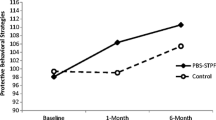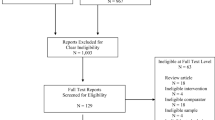Abstract
Purpose of Review
Addictive behaviors among college students are a significant public health concern. This manuscript reviews the past 2 years of the literature on prevention and treatment approaches for college students who engage in addictive behaviors.
Recent Findings
In-person skill-based interventions and motivational interventions that incorporate personalized feedback are effective in the short-term, but little support was found for long-term effects. Although web-based interventions reduced certain addictive behaviors (e.g., alcohol, problematic gambling), in-person interventions that include motivational interviewing components and personalized feedback appear to be more efficacious.
Summary
Research has largely focused on alcohol and little is known about the utility of interventions for students who use tobacco or illicit substances or who engage in problematic gambling. Research on interventions for these high-risk behaviors is recommended.
Similar content being viewed by others
References
Papers of particular interest, published recently, have been highlighted as: • Of importance
Johnston LD, O’Malley PM, Bachman JG, Schulenberg JE. Monitoring the future: national survey results on drug use, 1975-2012. Bethesda, MD: Department of Health and Human Services. 2013
Substance Abuse and Mental Health Services Administration. Results from the 2013 National Survey on Drug Use and Health: summary of national findings, NSDUH Series h-48. Rockville, MD. 2014
Kerr DL, Ding K, Chaya J. Substance use of lesbian, gay, bisexual and heterosexual college students. Am J Health Behav. 2014;38(6):951–62. doi:10.5993/AJHB.38.6.17.
Blinn-Pike L, Worthy SL, Jonkman JN. Disordered gambling among college students: a meta-analytic synthesis. J Gambl Stud. 2007;23(2):175–83.
Horton J. Identifying at-risk factors that affect college student success. Int J Proc Educ. 2015;7(1):83–101.
Terlecki MA, Ecker AH, Copeland AL, Buckner JD. Treating drug abuse. In: Correia CJ, Murphy JG, Barnett N, editors. College student alcohol abuse: a guide to assessment, intervention, and prevention. Hoboken: John Wiley & Sons; 2012.
Dennhardt AA, Murphy JG. Prevention and treatment of college student drug use: a review of the literature. Addict Behav. 2013;38(10):2607–18. doi:10.1016/j.addbeh.2013.06.006.
Miller MB, Leffingwell T, Claborn K, Meier E, Walters S, Neighbors C. Personalized feedback interventions for college alcohol misuse: an update of Walters & Neighbors (2005). Psychol Addict Behav. 2013;27(4):909–20. doi:10.1037/a0031174.
Blanco C, Okuda M, Wright C, Hasin DS, Grant BF, Liu S-M, et al. Mental health of college students and their non-college-attending peers: results from the National Epidemiologic Study on Alcohol and Related Conditions. Arch Gen Psychiatry. 2008;65(12):1429–37. doi:10.1001/archpsyc.65.12.1429.
Hingson R, White A. Prevalence and consequences of college student alcohol use. In: Correia C, Murphy J, Barnett N, editors. College student alcohol abuse: a guide to assessment, intervention, and prevention. Hoboken: John Wiley & Sons, Inc; 2012. p. 3–24.
Miller WR, Rollnick S. Motivational interviewing: preparing people for change. 3rd ed. Motivational interviewing: helping people change. New York: Guilford Press; 2012.
Dimeff LA. Brief alcohol screening and intervention for college students (BASICS): a harm reduction approach. Guilford Press; 1999
Terlecki MA, Buckner JD, Larimer ME, Copeland AL. The role of social anxiety in a brief alcohol intervention for heavy drinking college students. J Cogn Psychother. 2011;25(1):7–21. doi:10.1891/0889-8391.24.4.5.
Terlecki MA, Buckner JD, Larimer ME, Copeland AL. Brief motivational intervention for college drinking: the synergistic impact of social anxiety and perceived drinking norms. Psychol Addict Behav. 2012;26(4):917–23. doi:10.1037/a0027982.
Monahan CJ, McDevitt-Murphy ME, Dennhardt AA, Skidmore JR, Martens MP, Murphy JG. The impact of elevated posttraumatic stress on the efficacy of brief alcohol interventions for heavy drinking college students. Addict Behav. 2013;38(3):1719–25. doi:10.1016/j.addbeh.2012.09.004.
Merrill JE, Reid AE, Carey MP, Carey KB. Gender and depression moderate response to brief motivational intervention for alcohol misuse among college students. J Consult Clin Psychol. 2014;82(6):984–92. doi:10.1037/a0037039. Results of this study add to a growing body of literature demonstrating that college students with psychological problems, such as depression, may not fully benefit from BASICS interventions and thus may need more personalized interventions.
Terlecki MA, Buckner JD, Larimer ME, Copeland AL. Randomized controlled trial of brief alcohol screening and intervention for college students for heavy-drinking mandated and volunteer undergraduates: 12-month outcomes. Psychol Addict Behav. 2015;29(1):2. doi:10.1037/adb0000056.
Kazemi DM, Levine MJ, Qi L, Dmochowski J. Brief motivational intervention for heavy drinking mandated and voluntary freshmen: a 1-year follow-up assessment. Nurs Outlook. 2015;63(3):349–56. doi:10.1016/j.outlook.2014.11.002.
Logan DE, Kilmer JR, King KM, Larimer ME. Alcohol interventions for mandated students: behavioral outcomes from a randomized controlled pilot study. J Stud Alcohol Drugs. 2015;76(1):31–7. doi:10.15288/jsad.2015.76.31.
Fromme K, Marlatt GA, Baer JS, Kivlahan DR. The Alcohol Skills Training Program: a group intervention for young adult drinkers. J Subst Abuse Treat. 1994;11(2):143–54.
Linowski SA, DiFulvio GT, Fedorchak D, Puleo E. Effectiveness of an electronic booster session delivered to mandated students. Int Q Commun Health Educ. 2016;36(2):123–9. doi:10.1177/0272684x16628726.
Walters ST, Neighbors C. Feedback interventions for college alcohol misuse: what, why and for whom? Addict Behav. 2005;30(6):1168–82. doi:10.1016/j.addbeh.2004.12.005.
Neighbors C, Rodriguez LM, Rinker DV, Gonzales RG, Agana M, Tackett JL, et al. Efficacy of personalized normative feedback as a brief intervention for college student gambling: a randomized controlled trial. J Consult Clin Psychol. 2015;83(3):500. doi:10.1037/a0039125. Notably, this is the first PNF intervention for gambling among at-risk college students. Results indicated that a PNF intervention reduces perceived norms, reduces gambling problems, and reduces gambling. The effect of the intervention was mediated by reductions in perceived norms.
Bewick BM, West R, Gill J, O’May F, Mulhern B, Barkham M, et al. Providing web-based feedback and social norms information to reduce student alcohol intake: a multisite investigation. J Med Internet Res. 2010;12(5):86–96. doi:10.2196/jmir.1461.
Neighbors C, LaBrie JW, Hummer JF, Lewis MA, Lee CM, Desai S, et al. Group identification as a moderator of the relationship between perceived social norms and alcohol consumption. Psychol Addict Behav. 2010;24(3):522–8. doi:10.1037/a0019944.
Neighbors C, Lewis M, LaBrie J, DiBello A, Young C, Rinker D, et al. A multisite randomized trial of normative feedback for heavy drinking: social comparison versus social comparison plus correction of normative misperceptions. J Consult Clin Psychol. 2016. doi:10.1037/ccp0000067.
Walters ST, Vader AM, Harris TR. A controlled trial of web-based feedback for heavy drinking college students. Prev Sci. 2007;8(1):83–8. doi:10.1007/s11121-006-0059-9.
Doumas DM, Nelson K, DeYoung A, Renteria CC. Alcohol‐related consequences among first‐year university students: effectiveness of a web‐based personalized feedback program. J Coll Couns. 2014;17(2):150–62.
Bendtsen P, Bendtsen M, Karlsson N, White IR, McCambridge J. Online alcohol assessment and feedback for hazardous and harmful drinkers: findings from the AMADEUS-2 randomized controlled trial of routine practice in Swedish universities. J Med Internet Res. 2015;17(7):e170-e. doi:10.2196/jmir.4020.
Rodriguez LM, Neighbors C, Rinker DV, Lewis MA, Lazorwitz B, Gonzales RG, et al. Remote versus in-lab computer-delivered personalized normative feedback interventions for college student drinking. J Consult Clin Psychol. 2015;83(3):455–63. doi:10.1037/a0039030.
Lewis MA, Neighbors C. An examination of college student activities and attentiveness during a web-delivered personalized normative feedback intervention. Psychol Addict Behav. 2015;29(1):162. doi:10.1037/adb0000003.
Geisner IM, Varvil-Weld L, Mittmann AJ, Mallett K, Turrisi R. Brief web-based intervention for college students with comorbid risky alcohol use and depressed mood: does it work and for whom? Addict Behav. 2015;42:36–43. doi:10.1016/j.addbeh.2014.10.030.
Herman KC, Fahnlander B. A motivational intervention to reduce cigarette smoking among college students: overview and exploratory investigation. J Coll Couns. 2003;6(1):46.
Pardavila‐Belio MI, García‐Vivar C, Pimenta AM, Canga‐Armayor A, Pueyo‐Garrigues S, Canga‐Armayor N. Intervention study for smoking cessation in Spanish college students: pragmatic randomized controlled trial. Addiction. 2015;110(10):1676–83. doi:10.1111/add.13009.
Hutton HE, Wilson LM, Apelberg BJ, Tang EA, Odelola O, Bass EB, et al. A systematic review of randomized controlled trials: web-based interventions for smoking cessation among adolescents, college students, and adults. Nicotine Tobacco Res. 2011;13(4):227–38. doi:10.1093/ntr/ntq252.
Brown J. A review of the evidence on technology-based interventions for the treatment of tobacco dependence in college health. Worldviews Evid Based Nurs. 2013;10(3):150–62. doi:10.1111/wvn.12000.
Berg CJ, Stratton E, Sokol M, Santamaria A, Bryant L, Rodriguez R. Novel incentives and messaging in an online college smoking intervention. Am J Health Behav. 2014;38(5):668–80. doi:10.5993/AJHB.38.5.4.
Mussener U, Bendtsen M, Karlsson N, White IR, McCambridge J, Bendtsen P, et al. Effectiveness of short message service text-based smoking cessation intervention among university students: a randomized clinical trial. JAMA Intern Med. 2016;176(3):321–8. doi:10.1001/jamainternmed.2015.8260.
Lupton JR, Townsend JL. A systematic review and meta-analysis of the acceptability and effectiveness of university smoke-free policies. J Am Coll Health. 2015;63(4):238–47. doi:10.1080/07448481.2015.1015029. This meta-analytic review demonstrated that campus-wide policies, such as making campuses smoke-free, show promise in reducing tobacco use rates among college students.
American College Health Association. National College Health Assessment II: reference group executive summary fall 2012. Hanover, MD. 2013
Caldeira KM, Arria AM, O’Grady KE, Vincent KB, Wish ED. The occurrence of cannabis use disorders and other cannabis-related problems among first-year college students. Addict Behav. 2008;33:397–411. doi:10.1016/j.addbeh.2007.10.001.
Palmer RS, McMahon TJ, Moreggi DI, Rounsaville BJ, Ball SA. College student drug use: patterns, concerns, consequences, and interest in intervention. J Coll Stud Dev. 2012;1:124.
Palfai TP, Saitz R, Winter M, Brown TA, Kypri K, Goodness TM, et al. Web-based screening and brief intervention for student marijuana use in a university health center: pilot study to examine the implementation of eCHECKUP TO GO in different contexts. Addict Behav. 2014;39(9):1346–52. doi:10.1016/j.addbeh.2014.04.025. This study demonstrated that, although widely utilized, the Marijuana eCHECKUP TO GO did not reduce cannabis use or related problems among cannabis-using college students. These results highlight the need for more useful interventions for these students.
de Oliveira Christoff A, Boerngen-Lacerda R. Reducing substance involvement in college students: a three-arm parallel-group randomized controlled trial of a computer-based intervention. Addict Behav. 2015;45:164–71. doi:10.1016/j.addbeh.2015.01.019.
Yurasek AM, Dennhardt AA, Murphy JG. A randomized controlled trial of a behavioral economic intervention for alcohol and marijuana use. Exp Clin Psychopharmacol. 2015;23(5):332–8. doi:10.1037/pha0000025.
Nowak DE, Aloe AM. The prevalence of pathological gambling among college students: a meta-analytic synthesis, 2005–2013. J Gambl Stud. 2014;30(4):819–43. doi:10.1007/s10899-013-9399-0.
Martens MP, Arterberry BJ, Takamatsu SK, Masters J, Dude K. The efficacy of a personalized feedback-only intervention for at-risk college gamblers. J Consult Clin Psychol. 2015;83(3):494–9. doi:10.1037/a0038843.
Lee CM, Neighbors C, Lewis MA, Kaysen D, Mittmann A, Geisner IM, et al. Randomized controlled trial of a Spring Break intervention to reduce high-risk drinking. J Consult Clin Psychol. 2014;82(2):189–201. doi:10.1037/a0035743.
Author information
Authors and Affiliations
Corresponding author
Ethics declarations
Conflict of Interest
Julia Buckner reports that she is the principal investigator on a grant funded by the National Institute of Drug Abuse (1R34DA031937-01A1). Ashley Richter reports that she is being funded through a grant by the National Institute of Drug Abuse (1R34DA031937-01A1). Emily R. Jeffries, Austin W. Lemke, Sonia M. Shah, and Kimberlye E. Dean declare no conflicts of interest.
Human and Animal Rights and Informed Consent
This article does not contain any studies with human or animal subjects performed by any of the authors.
Additional information
This article is part of the Topical Collection on Addiction and College Students
Rights and permissions
About this article
Cite this article
Jeffries, E.R., Lemke, A.W., Shah, S.M. et al. Addictive Behavior Interventions Among College Students. Curr Addict Rep 3, 368–377 (2016). https://doi.org/10.1007/s40429-016-0117-8
Published:
Issue Date:
DOI: https://doi.org/10.1007/s40429-016-0117-8




